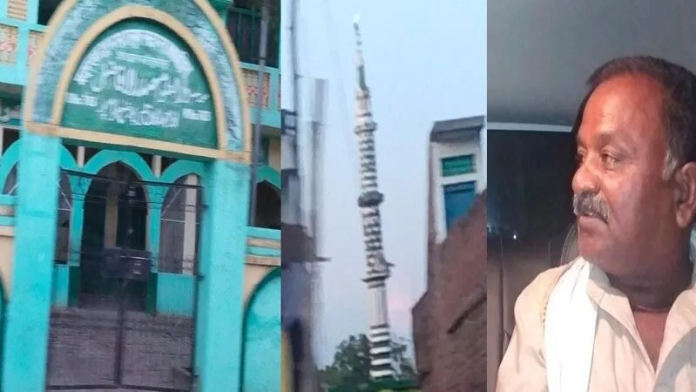Recently there have been several reports which suggest that the demographics along the Nepal-India border are changing rapidly. The number of mosques and madrasas is increasing continuously in these regions. The OpIndia team toured the border areas from August 20 to August 27, 2022, to assess the ground reality of the population of Muslims and Hindus. We have been reporting what we have witnessed in chronological order. Here is the 16th report of the series.
We have highlighted the Islamic religious sites on the Tulsipur-Harraiya road parallel to the Nepal border, some distance from the Tulsipur-Harraiya road up to Prem Nagar in our 15th report. We witnessed not just mosques erected in remote locations, but also madrasas and Mazars along the roadways. This time, we spoke with the locals we encountered along the way. They told us about their village and the problems in the surroundings.
Harish Chandra Sharma, the village head of Ahladdih village panchayat in Balrampur district, is one of the first people we met. We asked him specific questions concerning the border areas. The village head has historically been elected only by Sharma’s family for more than 20 years.
The rise in the dominance of Muslims in the last 20 years
Harish Chandra Sharma informed us that the demographic imbalance in his region is fast growing and that this imbalance has occurred at a very rapid rate in the previous 20 years. Sharma said that many strangers have migrated to his village and settled. Along with this, he stated that the primary cause of the imbalance is the rapid population growth among Muslims due to multiple marriages and more children. According to Harish Chandra, the population of Muslims in his neighbourhood has grown, as has their political and economic influence.

According to Sharma, when Hindus go to question the arrival of an outsider, the local Muslims come forward claiming them as their relative. He told that in this way they settle here and purchase land and property. Sharma confirmed that Hindus too sell their land to newcomer Muslims.
On the topic of Muslims spending large sums of money to acquire land, Sharma stated that while Muslims appear to be impoverished, they actually have a lot of money. He stated that they earn this money by working in large cities such as Mumbai. Sharma went on to add that the Hindu-Muslim ratio has changed from 70-30 to 50-50 as a result of the demographic shift.
He further stated that if a Muslim owns a room or property, he will only give it to a Muslim. With this, Muslims are continuously striving to acquire land, particularly around highways and crossings. He requested that his locality be monitored more closely by the authorities. He noted that no specific administrative action has been taken as of yet.
Several Muslim majority villages on the Nepal border
Sharma noted the villages around his village, such as Rehra and Khapri, as having a 100% Muslim population. He claims that just a few Dalit Hindu households exist among them. According to Harish Chandra Sharma, many Hindus in these villages recently sold their homes and relocated. He also mentioned the significant demographic change in the adjoining bazaar of Tulsipur.
Sharma stated that two madrasas and two mosques had been built in his village. One mosque is quite old, but the other was erected just in front of him. In addition, he stated that both madrasas in his area were built during the past 20 years. He stated that these madrasas are not state-funded.
According to Sharma, there is no harmony at Hindu festivities in his locality. He claims that because his village is Hindu-dominated, there is no disruption, but Hindus are unable to openly celebrate their festivals in adjacent villages such as Khaira. He described Khaira village as having roughly 90% Muslim residents and stated that it is one kilometre away from his village.
Sharma said, shockingly, that any outsider Muslim may simply get his name put on the voters’ list or ration card owing to influence. According to Sharma, one of the downsides is that outsiders profit from all of the government’s schemes, putting deserving Hindus at a disadvantage.
The village head highlighted Muslim-majority villages such as Gudaria, Rajwapur, and Khapripur. With this, he claimed that there are 20 villages within a 10-kilometre radius of him with a Muslim population of 70% or more. According to Harish Chandra Sharma, the Pradhans and other positions there are exclusively for Muslims, and the condition is such that Hindus stand nowhere in the competition. Sharma also named some villages where no Hindu contests elections.

